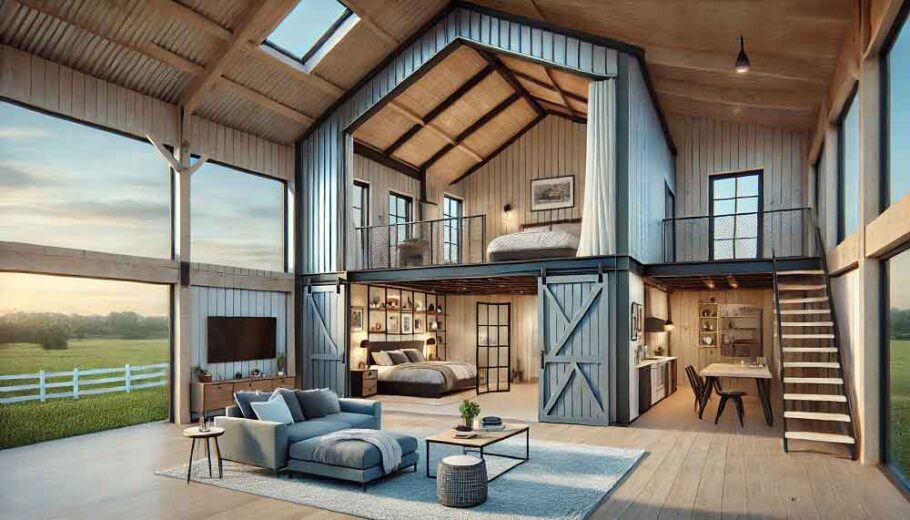When people think about barndominiums, the image that usually comes to mind is a wide-open post-frame structure—tall ceilings, large clear spans, and a steel or wood shell that emphasizes speed, affordability, and versatility. But what happens when a homeowner wants to expand that structure later with something entirely different, such as a traditional stick-built addition? Suddenly, the design becomes an engineering puzzle.
Post-frame and stick-built construction methods rely on very different structural principles, and integrating the two successfully requires a careful blend of architectural creativity and structural engineering rigor. In this article, we’ll explore the challenges, opportunities, and best practices for combining these two construction methods in a single barndominium project.
Why Mix Stick-Built and Post-Frame Construction?
Before digging into the complexities, it’s worth asking: Why would someone even want to attach a stick-built addition to a post-frame barndominium?
The answer lies in lifestyle changes and evolving family needs. While a barndominium offers open layouts and flexible living spaces, some homeowners later realize they want something more traditional, segmented, or stylistically distinct.
Common reasons include:
- Adding Bedrooms or a Second Living Wing: Families grow, and post-frame layouts can sometimes feel too open or hard to compartmentalize.
- Building a More Traditional Entryway: A gabled, stick-framed foyer can give the home curb appeal closer to conventional housing.
- Expanding with Specialized Rooms: Sunrooms, mudrooms, or hobby rooms are often easier to design in a stick-built format.
- Meeting Local Zoning or Appraisal Standards: Some areas value stick-built structures more highly, making them advantageous for resale.
The motivation makes sense. But when it comes to execution, the homeowner, architect, and engineer quickly face the realization that these two systems don’t “speak the same language.”
The Structural Divide: Post-Frame vs. Stick-Built
To understand the puzzle, let’s compare the systems.
- Load-Bearing Differences
- Post-Frame: Relies on widely spaced posts (often 8–12 feet apart) embedded in the ground or anchored to a slab, with girts and purlins carrying horizontal loads. The walls themselves aren’t load-bearing in the traditional sense.
- Stick-Built: Uses closely spaced studs (typically 16–24 inches apart) in continuous load paths from the roof down to the foundation. Walls carry vertical and lateral loads.
- Foundations
- Post-Frame: Can use embedded posts, pier foundations, or a floating slab.
- Stick-Built: Typically requires continuous footings or a basement wall system for uniform load transfer.
- Roof Systems
- Post-Frame: Long-span trusses, fewer load points, big open spaces.
- Stick-Built: Shorter trusses or rafters supported by bearing walls.
These mismatches make it difficult to simply “bolt on” one system to the other without engineering adjustments.
The Engineering Challenges of Integration
- Differential Settlement
Post-frame structures often rest on isolated piers or slab-on-grade, while stick-built additions typically use continuous footings. If one side of the building settles differently, cracks in drywall, uneven floors, or roof leaks can develop at the transition.
- Shear and Lateral Stability
A stick-built addition relies on shear walls for lateral stability. A post-frame structure resists wind and seismic forces through diaphragm action in the roof and walls. Connecting these two systems requires careful engineering so that forces distribute predictably, without overloading weak points.
- Roofline Integration
The roof system is often the most visible and complex integration challenge:
- Differing roof pitches between post-frame trusses and stick-built rafters.
- Potential snow and water buildup in valleys where the two systems meet.
- Load paths that need to be transferred without overstressing framing members.
- Thermal Bridging and Insulation
Post-frame barndominiums often rely on continuous insulation systems, while stick-built walls use cavity insulation. The junction between the two can easily become a thermal weak point if not carefully detailed.
- Aesthetic Cohesion
While not strictly engineering, tying together the very different proportions of a post-frame building and a stick-built wing requires architectural finesse. Without thoughtful design, the addition can look like an awkward afterthought.
Engineering Strategies to Make It Work
So how do engineers solve this puzzle? Here are several approaches.
- Unified Foundation Planning
Even if the barndominium already exists, an engineer can design a compatible foundation system for the addition. Sometimes this involves underpinning sections of the barndo or designing a hybrid foundation that bridges continuous footings with pier systems.
- Structural Isolation
In some cases, the best solution is to treat the stick-built addition almost like a separate building, joined with a covered breezeway or structural expansion joint. This allows each system to move independently without stressing the other.
- Over-Engineering the Transition Zone
Where the two structures meet, engineers may:
- Add steel brackets, laminated beams, or specialty connectors.
- Reinforce roof trusses or headers to carry unusual loads.
- Use shear panels or structural sheathing to distribute forces.
- Custom Roof Tie-Ins
Rather than trying to perfectly match pitches, engineers often design special trusses or transition rafters to create smooth rooflines. Careful flashing and waterproofing are critical to prevent leaks.
- Insulation and Envelope Detailing
Spray foam or exterior continuous insulation can bridge the gap between cavity-insulated walls and post-frame girts, minimizing thermal loss.
Real-World Scenarios
Let’s imagine three scenarios where this puzzle plays out differently:
- The Growing Family Wing
A family adds a stick-built two-bedroom wing to a post-frame barndominium. The solution? A continuous foundation under the new wing and a reinforced header system at the junction. The addition is structurally tied but carefully braced for differential movement. - The Traditional Porch Addition
A homeowner adds a stick-built front porch and foyer. Because the loads are minimal, engineers can tie into the existing posts, but special care is taken with the roof valley to avoid ice dams and leaks. - The Sunroom Transition
A stick-built sunroom connects with the post-frame living space via an expansion joint, allowing the glass-heavy addition to settle independently without cracking.
Costs and Trade-Offs
Integrating a stick-built addition with a post-frame barndominium is more expensive than sticking to one system. Added costs come from:
- Engineering fees for custom design.
- Specialized connectors and reinforcements.
- Roofing and waterproofing complexity.
- Potential foundation adjustments.
However, the trade-off is that homeowners get the best of both worlds: the open, affordable, and efficient space of a barndominium combined with the cozy, compartmentalized, or stylistically traditional features of a stick-built addition.
Best Practices for Homeowners
If you’re considering such a hybrid design, here are some tips:
- Involve an Engineer Early – Don’t let your contractor “wing it.” Structural mismatches can cause serious problems later.
- Plan for Future Additions in Advance – If you’re still in the design phase of your barndo, tell your engineer about your future plans so the foundation and framing can anticipate the connection.
- Budget for Custom Solutions – Hybrid construction is never as straightforward as it looks on paper.
- Think Aesthetically – Use matching siding, trim, and roof materials to create a unified appearance.
- Don’t Overcomplicate – Sometimes, a detached stick-built addition connected by a breezeway solves more problems than forcing a direct tie-in.
Conclusion: A Puzzle Worth Solving
Integrating a traditional stick-built addition with a post-frame barndominium is truly an engineering puzzle—but it’s one worth solving. It reflects the evolving way families use their homes: blending openness with tradition, affordability with long-term adaptability.
While the structural systems are different, with careful engineering, thoughtful design, and smart planning, these two worlds can come together seamlessly. The result is a home that grows with its owners—rooted in the strength of the post-frame method, but flexible enough to embrace the warmth and familiarity of stick-built design.

